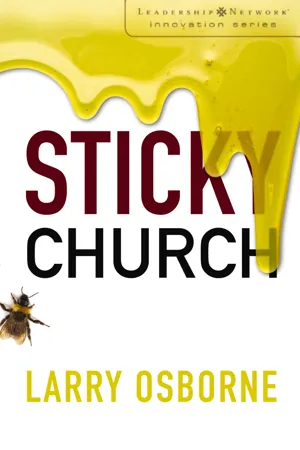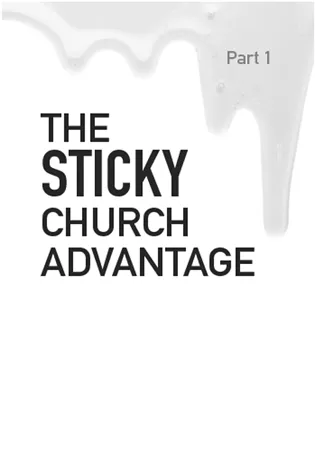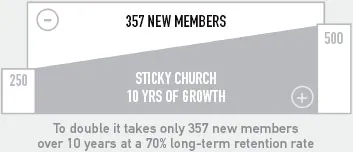![]()
![]()
Chapter 1
Sticky Church
If the back door of a church is left wide open, it doesn’t matter how many people are coaxed to come in the front door—or the side door, for that matter.
Yet most churches give the back door scant attention.
We’ve discovered lots of ways to reach people. We’ve offered the high-powered programs and slick marketing of attractional churches, the cultural savvy of missional churches, and the relational intimacy of small churches. But we’ve often become so focused on reaching people that we’ve forgotten the importance of keeping people.
And that’s the thesis of this book: Our churches need to be stickier.
Stickier churches are healthier churches. They not only draw in spiritual window-shoppers and lead them to Christ; they also grow them up to maturity.
And that, after all, is what Jesus called us to do. He didn’t tell us to go into all the world and sign people up. He didn’t tell us to draw big crowds. He told us to make disciples—a task that includes baptizing people and teaching them to obey everything he commanded. 1
Frankly, that’s a task that takes some significant time. To pull it off, we need to be sticky.
Why Stickiness Is So Important
In one of Jesus’ most famous parables, the parable of the sower, he told of a farmer casting seeds onto four types of soil, each representing a different response to the gospel.2
One of the soils was so hard that nothing could germinate.
Another was so shallow that the plants sprouted quickly but couldn’t dig their roots deep enough to withstand the furnace blast of a Middle Eastern summer’s day.
The third kind of soil was weed infested, resulting in a crop that once again looked good for a while but eventually was choked off by what Jesus called the deceitfulness of riches and the desire for other things.
Only the fourth type of soil, the one Jesus called the good soil, produced a harvest.
Now, the point of this parable is straightforward: A great spiritual start is no guarantee of a happy ending.
But somehow many of us have missed it.
Just look at the way we typically respond to a burst of church growth or the baby steps of a new believer. We’re quick to rejoice at the first signs of spiritual life—and rightfully so. But in most cases, while we hope that the growth lasts and continues, the sprouting of the seed is the main thing. That’s what we count; that’s what we celebrate.
If the seed dries up and dies at the first sign of hardship, we’re bummed. But we’re hardly devastated. At least it sprouted and popped out of the ground—and that’s a lot better than never having started at all.
The same goes for anyone who starts out well and lasts for a while before being choked off by the weeds of worldly concern. We wish it hadn’t happened. We wanted better for them. But at least they got off to a good start.
Here’s the problem. Unlike Jesus’ original audience, few of us know much about farming. For most of us, the produce aisle is a close encounter with agriculture. So we completely miss the emotional response that anyone raised on a farm would have had to this parable.
No farmer would ever be satisfied with initial growth killed off before harvest. If the soil in any portion of his field produced that result, he’d never plant there again.
A crop that didn’t last all the way to harvest was a financial disaster. The response wouldn’t be a shrug and an “Oh well.” It would be more akin to sackcloth and ashes.
I realize that most scholars see the soil in this parable as representing the condition of individual hearts—and I agree. But the underlying principles are not only true for individuals; they are also true for the ministry of a local church.
I also realize that this passage could easily springboard us into a centuries-old debate about eternal security. But that’s not my point or within the scope of this book. Wherever you personally land on that one, the question of the day remains the same: What does Jesus’ parable about the four soils have to say about the way we do church?
To my thinking it says a lot. And one of the most important things it says about our churches is that stickiness matters.
The Purpose of This Book
Don’t take what I’ve said to mean that I’m against trying to open the front door wider. I’m not. I’d like to open it as wide as possible. It’s just that I’ve learned that if left alone, the back door never closes itself. We have to intentionally slam it shut.
In the following pages we’ll explore how to do that. We’ll see what makes a church sticky, from its values and priorities to its structures, programs, and practices.
In particular we’ll look in depth at sermon-based small groups, a lecture-lab model for studying the weekend sermon in-depth during the week. We’ll see how they work. We’ll explain why they have the power to make your church especially sticky. And we’ll discover why so many of the traditional small group models we’ve tried in the past sound great but don’t work all that well in real life.
My goal is to provide you with a working model that you can adopt and change until it’s ready to be put into play in your unique ministry setting.
I’ve deliberately written in a conversational tone. I hope you’ll feel like we’re hanging out, discussing the ins and outs of ministry, sipping a latte at our favorite gathering place. I’ll tell you my story. You decide what works for you and what doesn’t.
Much of this story will be told through the lens of North Coast Church, located in a suburb north of San Diego. Since 1980 I’ve had the privilege of pastoring an amazing group of people who’ve been willing to innovate but also—perhaps more important—abandon programs and traditions that no longer work.
That means that these insights, programs, and principles have all been hammered out on the anvil of local church ministry, not only at North Coast Church but also in the many churches that have already adopted their own version of sermon-based small groups.
And unlike many books on ministry, this isn’t the result of a rush to publish. It’s not about the newest “next big thing.” It’s not based on an unproven track record of two or three years. It’s the result of decades of successes, failures, refinements, and midcourse corrections.
Even more important, these principles scale. They (and the sermon-based small group model) worked just as well when we were a small church of less than two hundred adults as they do today in a multisite megachurch with more than seven thousand in weekend attendance.
They’ve also proven to be transferable to a wide array of theological, denominational, and cultural backgrounds. They’ve helped close the back door in small, large, rural, suburban, and urban churches—as well as edgy churches and traditional churches.
The reason is quite simple. The need for stickiness is universal. The details of how we get there will vary from ministry to ministry. But the broad-brush principles are strikingly similar in every situation.
Here’s an interesting scenario for you to ponder. Imagine two churches that each grew in attendance from 250 people to 500 over a ten-year period.
Church A is a revolving door. It loses 7 people for every 10 it adds. To reach 500, it will have to add 834 new members or attenders.
Church B is a sticky church. It loses only 3 people for every 10 it adds. To reach 500, it has to add 357 new members or attenders.
On the surface, both churches appear to have doubled. But the revolving door church had to reach 834 new people to get there, while the sticky church only needed to reach 357.
Obviously, doubling attendance is a lot easier for the sticky church than for the revolving door church. No surprise there. But here’s the kicker: After ten years, the church with the big back door will have 500 attenders and 584 former attenders! And every year after that, the spread between the number of ex-attenders and the number of current attenders will grow larger.
No matter what that church does to expand the size of the front door, it’s going to be hard to keep reaching people when the predominant word on the street is, “I used to go there.”
![]()
Chapter 2
Who Are These Guys?
If I’m going to tell you what we’ve done, you have a right to know who we are. So here’s the North Coast story. When it comes to marketing and advertising, we stink. Almost all of our growth has come by word of mouth. That helps explain why and how stickiness became so important to our ministry. But here’s the rest of the story.
When I first came to North Coast, we were a small church meeting in an old high school cafeteria. I hadn’t been there long when someone showed me an advertisement we were putting in the local newspaper each weekend. You know the drill: We were supposedly the friendliest church in town, with great preaching, great worship, and a world-class children’s program.
The truth was, we had none of those things. Not even close. I’m not sure I would have kept coming if I hadn’t been the pastor.
The cafeteria was old and smelly. Remnants of food fights hung from the wall. One whole side of the room was a large Plexiglas window, which was cool—except when skateboarders started showing off in the middle of a sermon. That was hard to compete with. Most of the time they’d win. They were a lot more interesting than my early sermons. They’d probably still be more interesting. That’s one reason we moved.
So I did the only reasonable thing. I canceled the ad. I had enough issues on my hands. I didn’t need the Federal Communications Commission hassling me for false advertising.
From that point on, outside of a small listing in the yellow pages, we’ve never marketed or advertised. We’ve not held any special evangelistic weekends where people were asked to bring their friends. We’ve not even used the free advertising that some organizations offer churches for Easter and Christmas Eve.
That’s not to say I’m against marketing. Not in the least. We might do it someday. But to this point, we’ve opted to close the back door and grow by word of mouth, in the belief that even a small trickle can flood the whole house if everything is locked up tight.
Slamming the Back Door Shut
Basically, what we’ve done is to take most of the energy and resources we would have spent on special programming and front-door events and instead poured it into making our church more welcoming and sticky.
Rather than trying to have the most creative sermon series, the hippest worship, the best dog and pony show on Easter or Christmas Eve, we’ve simply tried to serve our people so well that they’ll want to bring their friends, without needing to be asked to do so.
Everything we do is aimed at helping the Christians we already have grow stronger in Christ. But everything is done in such a way that their non-Christian friends will understand all that we’re saying and doing. Bottom line: We’ve tried to create a perfect storm for come-and-see evangelism while velcroing newcomers for long-term spiritual growth.
I’m not saying we never have people walk out the back door. Of course we do. And sometimes it’s more than a...





